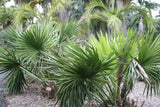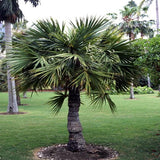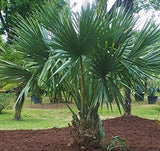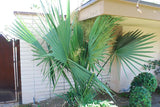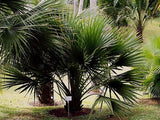Sabal minor Seeds — “Dwarf Palmetto”: Heart of the Swamp & Resilience in the Frost
From murky floodplains to limestone hammocks, Sabal minor is a palm that refuses to be fragile. These seeds carry the promise of blue-green tropical fronds that stand firm in cold snaps, habitat richness, and human stories stretching back centuries. A perfect pick for gardens seeking both toughness and beauty.
🌸 Bloom & Appearance
-
Bloom color: The flowers are white, sometimes yellowish-white, borne in large, compound panicles that often extend beyond the fan-shaped leaves. Blooming season tends toward late spring or early summer.
-
Fruit: After flowering, glossy black drupes appear (small, round berries) which persist into fall and provide modest yet important food for wildlife.
❄️ Hardiness & Growing Conditions
-
USDA Hardiness Zones: Typically Zones 7 through 10. In protected microclimates, especially for hardier ecotypes (for example ones from Oklahoma), Sabal minor can endure colder temperatures, sometimes dipping toward Zone 6 with extra winter protection.
-
Prefers full sun to part shade, moist to wet soils (often poorly drained), though once established can handle occasional dryness. Tolerant of seasonal flooding, swampy conditions, and even modest salt wind in sheltered spots. Mulching helps for winter protection.
🌿 Cultural Significance & Human Uses
-
Indigenous peoples, including Seminoles, Choctaw, Houma and other tribes, used Sabal minor leaves for many utilitarian purposes—thatching roofs, weaving baskets and fans, making lashings. The root or heart was baked by some in times of famine (“palmetto bread”). The leaves have long been part of craft and ritual.
-
In more recent garden and landscape culture, Sabal minor is prized for evoking a subtropical or coastal feel without demanding a tropical climate. In humid subtropical and warm temperate gardens, it is used for low-maintenance tropical accents, understory palms, rain gardens, and naturalizing in wetlands.
🐝 Wildlife Interactions & Ecological Role
-
The flowers are fragrant (as many sources note), attracting bees and other pollinating insects.
-
Fruit are eaten by birds (robins, mockingbirds, warblers) and small mammals, contributing to food webs especially in fall.
-
The evergreen foliage and dense thickets offer cover and nesting habitat for birds and small wildlife.
-
There is no reliable documented use of Sabal minor as a larval host (i.e. caterpillars feeding on the leaves) in mainstream species lists, but its flowers, nectar, and fruit do support pollinator and fruit-eating species broadly.
🌱 Growth, Shape & Lifespan
-
Grows slowly. Mature size is generally 4-9 feet tall and about the same or a bit wider in spread. In wetter, sunnier sites, leaf size is larger; in shady, cooler sites, more compact.
-
Often has a subterranean or very short trunk, especially in swamp shade; in sunnier or more open sites a short trunk may develop over many years.
✨ Why These Seeds Are Special
Each seed is a chance to nurture one of nature’s quiet champions: a palm that blends toughness and elegance, that supports wildlife, that carries both cultural legacy and ecological function. A seedling of Sabal minor will offer you:
-
Evergreen tropical foliage even in cold-winters (especially zones 7-10);
-
Fragrant white flowers, fruits that draw wildlife;
-
Ornamental value in landscapes large and small;
-
A plant that’s beautifully resilient—flood-capable, salt-tolerant, deer-resistant;
-
Soil versatility, from wet hammocks to acidic and neutral soils.
Planting these seeds is an investment of time and care, but the payoff is a living tapestry of wildlife, human tradition, and verdant beauty that endures.






